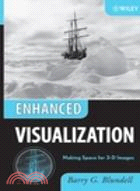Enhanced Visualization: Making Space For 3-D Images
商品資訊
ISBN13:9780471786290
出版社:John Wiley & Sons Inc
作者:Blundell
出版日:2007/02/09
裝訂/頁數:平裝/448頁
定價
:NT$ 6534 元優惠價
:90 折 5881 元
若需訂購本書,請電洽客服 02-25006600[分機130、131]。
商品簡介
作者簡介
名人/編輯推薦
目次
相關商品
商品簡介
This book builds on a previous work (‘Creative 3-D Display and Interaction Interfaces’) but may be read as a stand-alone book. A trans-disciplinary approach is adopted thereby making the content accessible to wide-ranging audiences from both the sciences and humanities. Additionally, the book is highly relevant to computer users who would like to learn more about new approaches to computer interaction, to those wishing to develop new forms of creative digital media and to those within industry who are involved in the advancement of computers and computer related products.
作者簡介
Barry G. Blundell, PhD, is a physicist and engineer who has worked in the area of 3-D display and interaction systems since the late 1980s. His research interests in the development of new forms of creative digital media are intended to advance natural and synergistic interaction with the digital world. The author is involved in promoting new technologies and techniques for distance education—particularly for use in third world countries—and also in highlighting ethical issues arising as a consequence of the deployment, networking, and accessibility of computer systems.
名人/編輯推薦
"…the book will give you both the scientific and factual basis to express the outcome of the visualisation process in the most effective way." (British Computer Society Book Reviews)
"…a wonderful introduction to multidimensional display systems for people new to the field, and can also serve as a great reference for practitioners." (Computing Reviews.com, September 13, 2007)
"…a wonderful introduction to multidimensional display systems for people new to the field, and can also serve as a great reference for practitioners." (Computing Reviews.com, September 13, 2007)
目次
Preface.
Acknowledgements.
Chapter One. Setting the Scene.
1.1 Introduction.
1.2 Historical Background.
1.2.1 Interaction.
1.2.2 The Display, Data Stream and Interaction Tool Interface.
1.2.3 The Conventional Display.
1.2.4 Raster and Vector Graphics.
1.3 Working within a 2-D Space.
1.4 Concerning Interaction.
1.5 Image and Interaction Spaces.
1.6 Introducing Volumetric and Varifocal Techniques.
1.6.1 The Volumetric Technique.
1.6.2 The Essence of the Volumetric paradigm.
1.6.3 The Varifocal Approach.
1.7 Discussion.
1.8 Investigations.
Chapter Two. Aspects of the Visual System.
2.1 Introduction.
2.2 Some Characteristics of the Eye.
2.3 Depth Cues.
2.3.1 Pictorial Cues.
2.3.2 Oculomotor Cues.
2.3.3 Motion Parallax.
2.3.4 Stereopsis (Binocular Parallax).
2.4 Considerations on Image Refresh.
2.5 Discussion.
2.6 Investigations.
Chapter 3. Creative 3-D Display Techniques.
3.1Introduction.
3.2 Display Subsystems.
3.3 Stereoscopic Techniques.
3.3.1 A ‘Fog Penetrating’ Televisor.
3.4Extending the Stereoscopic Approach.
3.5 The Physical 3-D Image and its Electronic Rendition.
3.6 Multi-view Displays.
3.7 On Painting and Sculpture.
3.7.1 Information Content.
3.7.2 Working within a 3-D Space.
3.7.3 Display Capability.
3.8 Discussion.
3.9 Investigations.
Chapter 4. The Swept-Volume Approach.
4.1 Introduction.
4.2 Exemplar Swept-Volume Techniques.
4.3 Swept-Volume Subsystems.
4.3.1 Image Space Creation.
4.3.2 Voxel Generation.
4.3.3 Voxel Activation.
4.4 Parallelism in Voxel Activation.
4.4.1 Restrictions in Voxel Activation.
4.4.2 Designing for Predictability.
4.5 Hardware Based Characterisation.
4.6 The Acceptance of Motion.
4.7 Dead Zones.
4.7.1 The Voxel Placement Dead Zone.
4.7.2 Distortional (Elongation) Dead Zone.
4.7.3 The Visual Dead Zone.
4.7.4 Other Forms of Dead Zone.
4.8 Discussion.
4.9 Investigations.
Chapter 5. The Static-Volume Approach.
5.1 Introduction.
5.2 An Elementary Static-Volume Implementation.
5.3 Image Space Composition.
5.4 The Classification of Static-Volume Systems.
5.5 Voxel Visibility.
5.6 Beam Intersection and the Stepwise Excitation of Fluorescence.
5.6.1 The Stepwise Excitation of Fluorescence in Gaseous Media.
5.6.2 The Stepwise Excitation of Fluorescence in Non-Gaseous Media.
5.7 The Photochromic Approach.
5.8 Dead Zones.
5.9 Discussion.
5.10 Investigations.
Chapter 6. Swept-Volume Systems: Limited Viewing Freedom.
6.1 Introduction.
6.2 Image Slices and Image Planes.
6.3 John Logie Baird Makes Space for the Third Dimension.
6.3.1 Perhaps the First Swept-Volume Displays.
6.3.2 Baird Advances Volumetric Image Depiction.
6.4 Parallel Image Planes Using Translational Motion.
6.4.1 A Reciprocating CRT.
6.4.2 Image Slices Focused onto a Moving Screen.
6.4.3 Image Slices Reflected by a Mirror: A Sinusoidal Velocity Profile.
6.4.4 The Peritron.
6.4.5 Image Slices Reflected using a Linearly Moving Mirror.
6.4.6 Image Slices Created using an Active Surface of Emission.
6.5 Parallel Image Planes Using Rotational Motion.
6.5.1 Image Planes Formed by Rotors Equipped with an Active Surface of Emission.
6.5.2 Image Planes Formed by the Rotation of a Series of Mirrors.
6.5.3 Image Planes Formed by the Rotation of a Fiber Optic Bundle.
6.5.4 The Archimedes Spiral Approach.
6.6 Discussion.
6.7 Investigations.
Chapter 7. Low Parallelism Swept-Volume Systems.
7.1 Introduction.
7.2 The Planar Screen and Fixed Beam Source(s).
7.2.1 The Planar Screen and Stationary Electron Gun(s).
7.2.2 The Video Frequency with Exhaustive Scanning.
7.3 The Planar Screen and Constant Beam Source Geometry.
7.3.1 The Planar Screen and Co-Rotating Electron Guns.
7.3.2 The Planar Screen and Non-Evasive Projection Techniques.
7.4 A Helical Screen and Passive SOE.
7.4.1 A Helix within a CRT.
7.4.2 HL3D Systems.
7.4.3 Projection onto a Helical screen.
7.5 Alternative Configurations.
7.5.1 A Tilted Planar Screen.
7.5.2 An Alternative Screen Shape.
7.5.3 Augmenting the Planar Screen.
7.5.4 A Sliced Fiber Bundle.
7.5.5 Two Degrees of Freedom.
7.6 An Early Volumetric Radar Display.
7.7 Discussion.
7.8 Investigations.
Chapter 8. Highly Parallel Swept-Volume Systems.
8.1 Introduction.
8.2 The Planar Screen and Active Surface of Emission.
8.3 The Planar Screen and Passive Surface of Emission.
8.3.1 A Plurality of Scanned Beam sources.
8.3.2 The Perspecta Display.
8.3.3 Images cast onto Rotating Mirrors.
8.4 The Helical Screen and Active Surface of Emission.
8.5 The Helical screen and Passive Surface of Emission.
8.6 The Relative Rotations of a Screen and an Array of Light Sources.
8.7 The Spinning Lens Approach.
8.8 Discussion.
8.9 Investigations.
Chapter 9. Static-Volume Systems: Example Implementations.
9.1 Introduction.
9.2 The Use of an Active Matrix of Voxel Generation Elements.
9.2.1 From Bulbs to Gas Discharge.
9.2.2 A Gas Discharge Display.
9.2.3 An Optical Fiber Technique.
9.2.4 A Stack of LCD Panels Illuminated with Polarized Light.
9.3 Voxel Activation Using Directed Beam Sources.
9.3.1 Electron Beams and a Series of Screen Meshes.
9.3.2 An Image Space Comprising Dust Particles.
9.4 The DepthCube?
9.5 The Beam Intersection Approach.
9.5.1 The Stepwise Excitation of Mercury Vapour.
9.5.2 Erbium Doped Calcium Fluoride.
9.5.3 Rare Earth Doped ZBLAN.
9.5.4 The use of Phosphor Particles Dispersed in a 3-D Medium.
9.5.5 Beam Intersection in a Phosphor Cloud.
9.5.6 The Intersection of Particle Beams in a Gas.
9.6 Stacking Image Slices.
9.6.1 The Use of Beam Splitters: Basic Configuration.
9.6.2 The Use of Beam Splitters: With Additional Optical Components.
9.7 Discussion.
9.8 Investigations.
Chapter 10. Varifocal Mirror Techniques.
10.1 Introduction.
10.2 The Geometry of the Curved Mirror.
10.3 Spherical Aberration.
10.4 Technical Considerations.
10.4.1 Image Update and Acoustic Noise.
10.4.2 Mirror Motion.
10.5 Varifocal Display System Development.
10.5.1 The Work of Alan Traub.
10.5.2 The Work of Eric Rawson.
10.5.3 The Work of Lawrence Sher.
10.5.4 The Application of the Varifocal Mirror to Medical Imaging.
10.5.5 The Work of King and Berry.
10.5 Discussion.
10.6 Investigations.
Chapter 11. The Graphics Pipeline and Interaction Issues.
11.1 Introduction.
11.2 Graphics Engine: Input and Output.
11.3 The Graphics Engine: Sequential Voxel Activation.
11.4 The Graphics Engine: Parallel Voxel Activation.
11.4.1 A Parallel Architecture.
11.5 Parallel Data Transfer.
11.6 Concerning Interaction.
11.6.1 The ‘Free Space’ Image.
11.6.2 ?Free? Image Space: Directly Generated and Projection Techniques.
11.7 Discussion.
11.8 Investigations.
Chapter 12. General Discussion: Suggestions Du Jour.
12.1 Introduction.
12.2 The Varifocal Technique.
12.3 Do Electron Beams Have a Future Role in Voxel Activation?.
12.4 Gas Discharge Devices.
12.5 The Stepwise Excitation of Fluorescence.
12.6 Other Approaches.
12.7 Discussion.
Appendix: A General Summary of Some Swept-Volume Display Characteristics.
References.
Index.
Acknowledgements.
Chapter One. Setting the Scene.
1.1 Introduction.
1.2 Historical Background.
1.2.1 Interaction.
1.2.2 The Display, Data Stream and Interaction Tool Interface.
1.2.3 The Conventional Display.
1.2.4 Raster and Vector Graphics.
1.3 Working within a 2-D Space.
1.4 Concerning Interaction.
1.5 Image and Interaction Spaces.
1.6 Introducing Volumetric and Varifocal Techniques.
1.6.1 The Volumetric Technique.
1.6.2 The Essence of the Volumetric paradigm.
1.6.3 The Varifocal Approach.
1.7 Discussion.
1.8 Investigations.
Chapter Two. Aspects of the Visual System.
2.1 Introduction.
2.2 Some Characteristics of the Eye.
2.3 Depth Cues.
2.3.1 Pictorial Cues.
2.3.2 Oculomotor Cues.
2.3.3 Motion Parallax.
2.3.4 Stereopsis (Binocular Parallax).
2.4 Considerations on Image Refresh.
2.5 Discussion.
2.6 Investigations.
Chapter 3. Creative 3-D Display Techniques.
3.1Introduction.
3.2 Display Subsystems.
3.3 Stereoscopic Techniques.
3.3.1 A ‘Fog Penetrating’ Televisor.
3.4Extending the Stereoscopic Approach.
3.5 The Physical 3-D Image and its Electronic Rendition.
3.6 Multi-view Displays.
3.7 On Painting and Sculpture.
3.7.1 Information Content.
3.7.2 Working within a 3-D Space.
3.7.3 Display Capability.
3.8 Discussion.
3.9 Investigations.
Chapter 4. The Swept-Volume Approach.
4.1 Introduction.
4.2 Exemplar Swept-Volume Techniques.
4.3 Swept-Volume Subsystems.
4.3.1 Image Space Creation.
4.3.2 Voxel Generation.
4.3.3 Voxel Activation.
4.4 Parallelism in Voxel Activation.
4.4.1 Restrictions in Voxel Activation.
4.4.2 Designing for Predictability.
4.5 Hardware Based Characterisation.
4.6 The Acceptance of Motion.
4.7 Dead Zones.
4.7.1 The Voxel Placement Dead Zone.
4.7.2 Distortional (Elongation) Dead Zone.
4.7.3 The Visual Dead Zone.
4.7.4 Other Forms of Dead Zone.
4.8 Discussion.
4.9 Investigations.
Chapter 5. The Static-Volume Approach.
5.1 Introduction.
5.2 An Elementary Static-Volume Implementation.
5.3 Image Space Composition.
5.4 The Classification of Static-Volume Systems.
5.5 Voxel Visibility.
5.6 Beam Intersection and the Stepwise Excitation of Fluorescence.
5.6.1 The Stepwise Excitation of Fluorescence in Gaseous Media.
5.6.2 The Stepwise Excitation of Fluorescence in Non-Gaseous Media.
5.7 The Photochromic Approach.
5.8 Dead Zones.
5.9 Discussion.
5.10 Investigations.
Chapter 6. Swept-Volume Systems: Limited Viewing Freedom.
6.1 Introduction.
6.2 Image Slices and Image Planes.
6.3 John Logie Baird Makes Space for the Third Dimension.
6.3.1 Perhaps the First Swept-Volume Displays.
6.3.2 Baird Advances Volumetric Image Depiction.
6.4 Parallel Image Planes Using Translational Motion.
6.4.1 A Reciprocating CRT.
6.4.2 Image Slices Focused onto a Moving Screen.
6.4.3 Image Slices Reflected by a Mirror: A Sinusoidal Velocity Profile.
6.4.4 The Peritron.
6.4.5 Image Slices Reflected using a Linearly Moving Mirror.
6.4.6 Image Slices Created using an Active Surface of Emission.
6.5 Parallel Image Planes Using Rotational Motion.
6.5.1 Image Planes Formed by Rotors Equipped with an Active Surface of Emission.
6.5.2 Image Planes Formed by the Rotation of a Series of Mirrors.
6.5.3 Image Planes Formed by the Rotation of a Fiber Optic Bundle.
6.5.4 The Archimedes Spiral Approach.
6.6 Discussion.
6.7 Investigations.
Chapter 7. Low Parallelism Swept-Volume Systems.
7.1 Introduction.
7.2 The Planar Screen and Fixed Beam Source(s).
7.2.1 The Planar Screen and Stationary Electron Gun(s).
7.2.2 The Video Frequency with Exhaustive Scanning.
7.3 The Planar Screen and Constant Beam Source Geometry.
7.3.1 The Planar Screen and Co-Rotating Electron Guns.
7.3.2 The Planar Screen and Non-Evasive Projection Techniques.
7.4 A Helical Screen and Passive SOE.
7.4.1 A Helix within a CRT.
7.4.2 HL3D Systems.
7.4.3 Projection onto a Helical screen.
7.5 Alternative Configurations.
7.5.1 A Tilted Planar Screen.
7.5.2 An Alternative Screen Shape.
7.5.3 Augmenting the Planar Screen.
7.5.4 A Sliced Fiber Bundle.
7.5.5 Two Degrees of Freedom.
7.6 An Early Volumetric Radar Display.
7.7 Discussion.
7.8 Investigations.
Chapter 8. Highly Parallel Swept-Volume Systems.
8.1 Introduction.
8.2 The Planar Screen and Active Surface of Emission.
8.3 The Planar Screen and Passive Surface of Emission.
8.3.1 A Plurality of Scanned Beam sources.
8.3.2 The Perspecta Display.
8.3.3 Images cast onto Rotating Mirrors.
8.4 The Helical Screen and Active Surface of Emission.
8.5 The Helical screen and Passive Surface of Emission.
8.6 The Relative Rotations of a Screen and an Array of Light Sources.
8.7 The Spinning Lens Approach.
8.8 Discussion.
8.9 Investigations.
Chapter 9. Static-Volume Systems: Example Implementations.
9.1 Introduction.
9.2 The Use of an Active Matrix of Voxel Generation Elements.
9.2.1 From Bulbs to Gas Discharge.
9.2.2 A Gas Discharge Display.
9.2.3 An Optical Fiber Technique.
9.2.4 A Stack of LCD Panels Illuminated with Polarized Light.
9.3 Voxel Activation Using Directed Beam Sources.
9.3.1 Electron Beams and a Series of Screen Meshes.
9.3.2 An Image Space Comprising Dust Particles.
9.4 The DepthCube?
9.5 The Beam Intersection Approach.
9.5.1 The Stepwise Excitation of Mercury Vapour.
9.5.2 Erbium Doped Calcium Fluoride.
9.5.3 Rare Earth Doped ZBLAN.
9.5.4 The use of Phosphor Particles Dispersed in a 3-D Medium.
9.5.5 Beam Intersection in a Phosphor Cloud.
9.5.6 The Intersection of Particle Beams in a Gas.
9.6 Stacking Image Slices.
9.6.1 The Use of Beam Splitters: Basic Configuration.
9.6.2 The Use of Beam Splitters: With Additional Optical Components.
9.7 Discussion.
9.8 Investigations.
Chapter 10. Varifocal Mirror Techniques.
10.1 Introduction.
10.2 The Geometry of the Curved Mirror.
10.3 Spherical Aberration.
10.4 Technical Considerations.
10.4.1 Image Update and Acoustic Noise.
10.4.2 Mirror Motion.
10.5 Varifocal Display System Development.
10.5.1 The Work of Alan Traub.
10.5.2 The Work of Eric Rawson.
10.5.3 The Work of Lawrence Sher.
10.5.4 The Application of the Varifocal Mirror to Medical Imaging.
10.5.5 The Work of King and Berry.
10.5 Discussion.
10.6 Investigations.
Chapter 11. The Graphics Pipeline and Interaction Issues.
11.1 Introduction.
11.2 Graphics Engine: Input and Output.
11.3 The Graphics Engine: Sequential Voxel Activation.
11.4 The Graphics Engine: Parallel Voxel Activation.
11.4.1 A Parallel Architecture.
11.5 Parallel Data Transfer.
11.6 Concerning Interaction.
11.6.1 The ‘Free Space’ Image.
11.6.2 ?Free? Image Space: Directly Generated and Projection Techniques.
11.7 Discussion.
11.8 Investigations.
Chapter 12. General Discussion: Suggestions Du Jour.
12.1 Introduction.
12.2 The Varifocal Technique.
12.3 Do Electron Beams Have a Future Role in Voxel Activation?.
12.4 Gas Discharge Devices.
12.5 The Stepwise Excitation of Fluorescence.
12.6 Other Approaches.
12.7 Discussion.
Appendix: A General Summary of Some Swept-Volume Display Characteristics.
References.
Index.
主題書展
更多
主題書展
更多書展今日66折
您曾經瀏覽過的商品
購物須知
外文書商品之書封,為出版社提供之樣本。實際出貨商品,以出版社所提供之現有版本為主。部份書籍,因出版社供應狀況特殊,匯率將依實際狀況做調整。
無庫存之商品,在您完成訂單程序之後,將以空運的方式為你下單調貨。為了縮短等待的時間,建議您將外文書與其他商品分開下單,以獲得最快的取貨速度,平均調貨時間為1~2個月。
為了保護您的權益,「三民網路書店」提供會員七日商品鑑賞期(收到商品為起始日)。
若要辦理退貨,請在商品鑑賞期內寄回,且商品必須是全新狀態與完整包裝(商品、附件、發票、隨貨贈品等)否則恕不接受退貨。
























